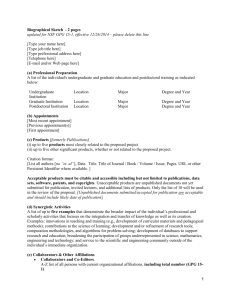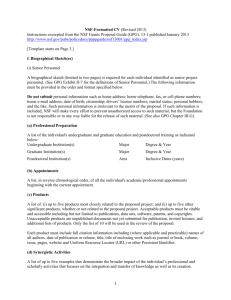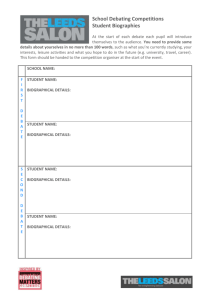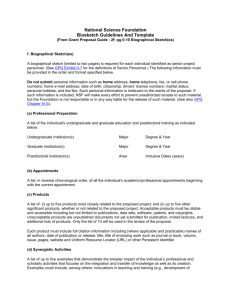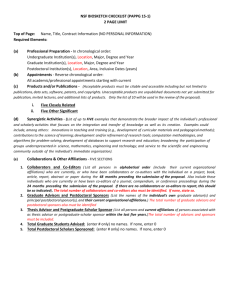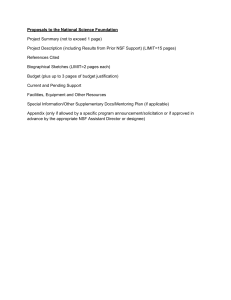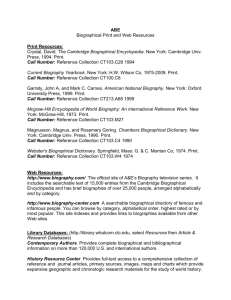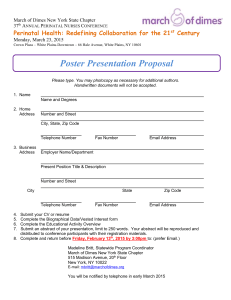Nsf Biosketch - Center for Research Program Development and
advertisement
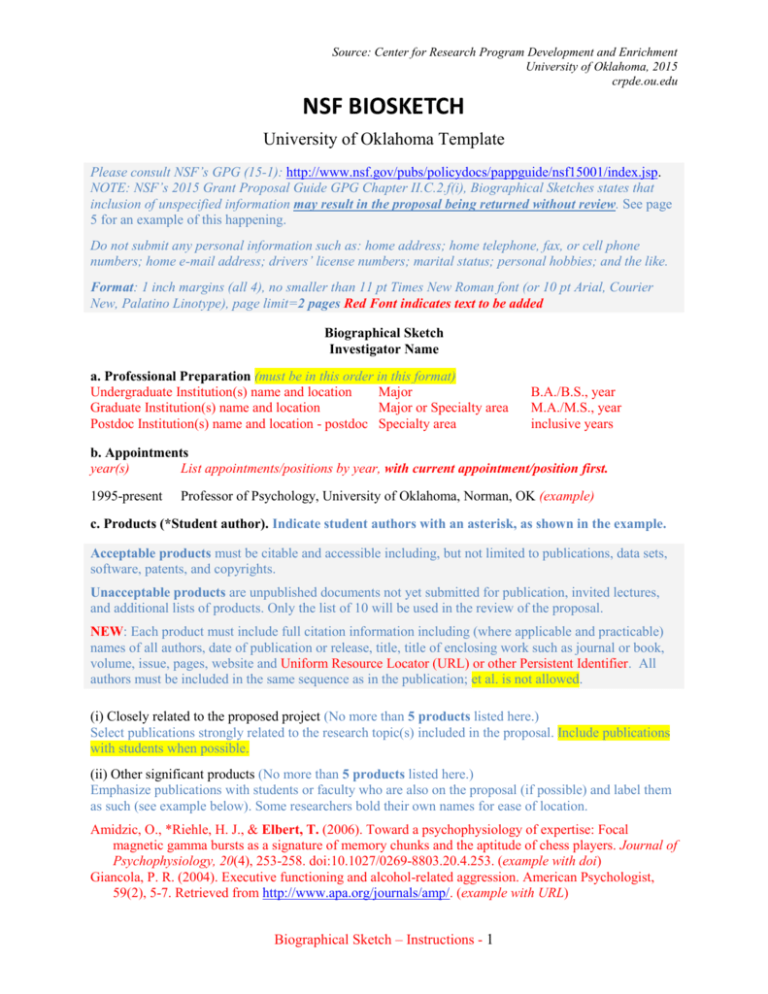
Source: Center for Research Program Development and Enrichment University of Oklahoma, 2015 crpde.ou.edu NSF BIOSKETCH University of Oklahoma Template Please consult NSF’s GPG (15-1): http://www.nsf.gov/pubs/policydocs/pappguide/nsf15001/index.jsp. NOTE: NSF’s 2015 Grant Proposal Guide GPG Chapter II.C.2.f(i), Biographical Sketches states that inclusion of unspecified information may result in the proposal being returned without review. See page 5 for an example of this happening. Do not submit any personal information such as: home address; home telephone, fax, or cell phone numbers; home e-mail address; drivers’ license numbers; marital status; personal hobbies; and the like. Format: 1 inch margins (all 4), no smaller than 11 pt Times New Roman font (or 10 pt Arial, Courier New, Palatino Linotype), page limit=2 pages Red Font indicates text to be added Biographical Sketch Investigator Name a. Professional Preparation (must be in this order in this format) Undergraduate Institution(s) name and location Major Graduate Institution(s) name and location Major or Specialty area Postdoc Institution(s) name and location - postdoc Specialty area B.A./B.S., year M.A./M.S., year inclusive years b. Appointments year(s) List appointments/positions by year, with current appointment/position first. 1995-present Professor of Psychology, University of Oklahoma, Norman, OK (example) c. Products (*Student author). Indicate student authors with an asterisk, as shown in the example. Acceptable products must be citable and accessible including, but not limited to publications, data sets, software, patents, and copyrights. Unacceptable products are unpublished documents not yet submitted for publication, invited lectures, and additional lists of products. Only the list of 10 will be used in the review of the proposal. NEW: Each product must include full citation information including (where applicable and practicable) names of all authors, date of publication or release, title, title of enclosing work such as journal or book, volume, issue, pages, website and Uniform Resource Locator (URL) or other Persistent Identifier. All authors must be included in the same sequence as in the publication; et al. is not allowed. (i) Closely related to the proposed project (No more than 5 products listed here.) Select publications strongly related to the research topic(s) included in the proposal. Include publications with students when possible. (ii) Other significant products (No more than 5 products listed here.) Emphasize publications with students or faculty who are also on the proposal (if possible) and label them as such (see example below). Some researchers bold their own names for ease of location. Amidzic, O., *Riehle, H. J., & Elbert, T. (2006). Toward a psychophysiology of expertise: Focal magnetic gamma bursts as a signature of memory chunks and the aptitude of chess players. Journal of Psychophysiology, 20(4), 253-258. doi:10.1027/0269-8803.20.4.253. (example with doi) Giancola, P. R. (2004). Executive functioning and alcohol-related aggression. American Psychologist, 59(2), 5-7. Retrieved from http://www.apa.org/journals/amp/. (example with URL) Biographical Sketch – Instructions - 1 Source: Center for Research Program Development and Enrichment University of Oklahoma, 2015 crpde.ou.edu d. Synergistic Activities A list of up to five examples that demonstrate the broader impact of the individual’s professional and scholarly activities that focuses on the integration and transfer of knowledge as well as its creation. Examples could include, among others: innovations in teaching and training (e.g., development of curricular materials and pedagogical methods); contributions to the science of learning; development and/or refinement of research tools; computation methodologies, and algorithms for problem-solving; development of databases to support research and education; broadening the participation of groups underrepresented in science, mathematics, engineering and technology; and service to the scientific and engineering community outside of the individual’s immediate organization. For example: (1) International collaboration: Established international partnership with La Universidad Autónoma Tomás Frías (UATF) and El Centro de Investigacion Minero Ambiental (CIMA) in Potosi, Bolivia; two formal agreements to bring sustainable treatment technologies to water pollution problems in one of the poorest nations in the Western Hemisphere (2011-present). (2) STEM Outreach: Developed and teach a new 4000/5000 level course “Science, Engineering, and Mathematics Educational Outreach for STEM Majors”, which is designed for STEM majors interested in educational outreach. This course introduces the fundamentals of cognition, educational psychology and pedagogy, and relates them to learning. Best teaching practices, school cultural issues, gender issues, and ethnic cultural issues are explored. Two authentic, guided inquiry-based STEM lessons are developed and taught in K-12 classrooms or similar education venues. Field site observations and interactions with educational professionals are use to emphasize practical application of learning theory (2001 – present). (3) Broadening participation: serve as a mentor for The University of Oklahoma McNair Scholars Program, mentor undergraduate student researchers through the Oklahoma Louis Stokes Alliance for Minority Participation in Science, Technology, Engineering, and Mathematics, and support a Bridge to the Doctorate Fellow in my lab (2008 – present). e. Collaborators & Other Affiliations Collaborators and Co-Editors (previous 48 months) NEW in 2015: First and Last Names and current affiliations – DO NOT FORGET the current organizational affiliations – in alphabetical order by last name. Include everyone who is currently, or has been a collaborator or co-author with the individual on a project, book, article, report, abstract or paper during the 48 months preceding the proposal submission date. Also include those individuals who are currently or have been co-editors of a journal, compendium, or conference proceedings during the 24 months prior to the proposal submission date. The total number of collaborators and co-editors also must be identified. If there are no collaborators or co-editors to report, this should be so indicated. For collaborative projects, include participants who are also on the proposal with whom you have collaborated and highlight them in bold font adding a note that these individuals are participants on the proposal as well as collaborators. Recommended: First Name (or initial) Last Name (Affiliation); See examples below. From GPG 15-1: The information in section (e) of the biographical sketch is used to help identify potential conflicts or bias in the selection of reviewers. See GPG Exhibit II-2 for additional information. e. Collaborators & Other Affiliations Collaborators and Co-Editors (previous 48 months) Deniz Aktas (OU); Toby Allen (OU); Matt Ashby (Taxon Biosciences, Tiburon, CA); Rachel Austin (Bates College); Felipe Bastida (Helmholtz Centre for Environmental Research, Germany); Robert Borden (North Carolina State U./Solutions IES); Irene Davidova (OU); Megan Elwood Madden (OU); Lisa Gieg (U Calgary, Canada); John T. Groves (Princeton U); Terry Hazen (U Tennessee); Bradley J. Biographical Sketch – Instructions - 2 Source: Center for Research Program Development and Enrichment University of Oklahoma, 2015 crpde.ou.edu Huizinga (ConocoPhillips, Oklahoma); Crystal Johnson (OU); Nicole Kimes (Universidad Miguel Hernandez, Spain); Jerome Kukor (Rutgers U); Paul Lawson (OU); J Tony Lieberman (Solutions IES, North Carolina); Maria Mastalerz (Indiana Geological Survey/Indiana U); Michael McInerney (OU); Mark Nanny (OU); Inés Pereria (Universidade Nova de Lisboa, Portugal); Kristen Savage-Ashlock (Oklahoma State U); Meghan Tierney (EPA); Joy Van Nostrand (OU); Jeffrey Voltz (OU); Friedrich Widdel (Max Planck Institute, Germany); (26 collaborators: Bold = participating in this proposal). Graduate Advisors and Postdoctoral Sponsors NEW RULES for 2015: A list of the names of the individual’s own graduate advisor(s) and principal postdoctoral sponsor(s), and their current organizational affiliations. The total number of graduate advisors and postdoctoral sponsors also must be identified Graduate Advisors and Postdoctoral Sponsors (Total = #) PhD Advisor (s): Name (Current Affiliation) Postdoctoral Advisor: Name (Current Affiliation) Thesis Advisor and Postgraduate-Scholar Sponsor Names and current affiliations for grad students and postdocs advisees in the past 5 years – DO NOT FORGET the current affiliations. This shows your training experience and involvement of students. You could also indicate women and minorities here as well. See example below. A list of all persons (including their organizational affiliations), with whom the individual has had an association as thesis advisor or as a postgraduate-scholar sponsor. Provide the total number of graduate students advised and postdoctoral scholars sponsored. Thesis Advisor and Postgraduate-Scholar Sponsor (past 5 years, *women) J Paritte* (Ph.D. 2009) – DVM Student, Oklahoma State U; L Niemann* (MS 2009) – Louisville Public School Teacher, Louisville KY; D Landoll*(MS 2011) – Ph. D. Student OU; T Al-Ali (MS 2012)– Returned to Iraq in December 2012; JR Shipley (MS 2011) – Ph.D. Student, Cornell U; C Swynden (MS 2012) – Instructor OU; Elizabeth Burba (Ph.D 2012) – Instructor Northeastern Oklahoma State U; E Bridge (Postdoc) – Assistant Professor OU; L* Zarones (Postdoc) – Contract Biologist Marianas Islands Number of graduate students advised: 12 (5 women); Number of postdoctoral scholars sponsored: 3 (1 woman) The GPG states that if a biographical sketch(es) is not required, the proposer should insert text or upload a document in this section of the proposal that states, “Not Applicable.” In FastLane, if biographical sketches for all senior personnel are uploaded in a single PDF file associated with the PI, the proposer should insert text or upload a document that states, “Not Applicable” for any co-PI or Senior Person. A TEMPLATE FOLLOWS Biographical Sketch – Instructions - 3 Source: Center for Research Program Development and Enrichment University of Oklahoma, 2015 crpde.ou.edu Biographical Sketch Investigator Name a. Professional Preparation Institution name and location Institution name and location Institution name and location Institution name and location - postdoc Major Major or Specialty area Major or Specialty area Specialty area B.A./B.S., year M.A./M.S., year Ph.D. year inclusive years b. Appointments year(s) Position, institution, location 1995-present Professor of Psychology, University of Oklahoma, Norman, OK (example) c. Products (*Student author). (i) Closely related to the proposed project (ii) Other significant products d. Synergistic Activities (1) First (Dates) (2) Second (Dates) (3) Third (Dates) (4) Fourth (Dates) (5) Fifth (Dates) e. Collaborators & Other Affiliations Collaborators and Co-Editors (previous 48 months) Recommended: First Name (or initial) Last Name (Affiliation); (Participating in this proposal) Graduate Advisors and Postdoctoral Sponsors (Total = #) PhD Advisor(s): Name (Current Affiliation) Postdoctoral Advisor (s): Name (Current Affiliation) Thesis Advisor and Postgraduate-Scholar Sponsor (past 5 years, *women) Number of graduate students advised: 12 (# women); Number of postdoctoral scholars sponsored: 3 (# women) Times New Roman 11 point font 1 inch margins on all sides Biographical Sketch – Instructions - 1 Source: Center for Research Program Development and Enrichment University of Oklahoma, 2015 crpde.ou.edu Example of Proposal returned for noncompliant supporting documents Subject: NSF Big Team Proposal Noncompliance – 1520000 Date: December 17, 2014 at 4:16:58 PM CST National Science Foundation - Big Team Program 4201 Wilson Blvd. Suite 980; Arlington, VA 22230 This email is in regards to your recent submission to the Big Team solicitation. In accordance with the National Science Foundation Grant Proposal Guide <http://www.nsf.gov/publications/pub_summ.jsp?ods_key=gpg>, your proposal 1520000 ("title") is noncompliant: Dr. A’s Biographical Sketch has included an additional section on "Selected Awards and Honors" that is not permitted under the Grant Proposal Guide. This section must be removed. The text at the beginning of the "Products" section of the Biographical Sketches for Drs. B, C, D, and A must be removed, and if desired can be combined into the Synergistic Activities section. Dr. E’s Biographical Sketch provides details about his positions that are considered to be a position description; the GPG requires only "a list, in reverse chronological order, of all the individual's academic/professional appointments beginning with the current appointment". Details such as "courses taught", "new courses introduced", and "key projects" should be removed or incorporated into the Synergistic Activities section as appropriate. Dr. E’s Biographical Sketch includes a section on Professional Service that should be removed or incorporated into the Synergistic Activities section as appropriate. Dr. E’s Biographical Sketch includes a section on "Honors/Awards" that is not permitted under the Grant Proposal Guide. This section must be removed The Collaborators section of Dr. C’s Biographical Sketch is missing names and current institutional affiliations of the person’s thesis advisees (all time) and/or postdoctoral advisees (within the past five years). These must be included, or you should state that they are not applicable. The letter from Dr. F, in the Supplementary Documents section, is considered a Letter of Support, which violates PAPPG guidelines. The letter must be replaced with a Letter of Commitment, or it must be removed from the proposal. A letter is regarded as a Letter of Support if it contains evaluative comments about the PI or project. A Letter of Commitment provides access to personnel, facilities, information, or other resources without making any evaluative claims about the project. Please note that the PAPPG states “…unless required by a specific program solicitation, letters of support should not be submitted as they are not a standard component of an NSF proposal, and, if included, a reviewer is under no obligation to review these materials. Letters of support submitted in response to a program solicitation requirement must be unique to the specific proposal submitted and cannot be altered without the author’s explicit prior approval” (PAPP Guide Part I: Grant Proposal Guide (GPG) Chapter II.C.2.j.). Please log into FastLane https://www.fastlane.nsf.gov and go to the proposal file update section to make the necessary update. If you need assistance with making the update or accessing FastLane please contact the FastLane help desk at 1-800-673-6188. Also note that once you complete the update you will need to allow access to your SRO so that they can submit the update, just as they did with the original proposal. Once the update has been submitted, please notify me via phone or email. Please make the necessary changes no later than Wednesday, 24 December at 5 pm to avoid any delays with the review of your proposal. If your update is not submitted to us within the required time frame or if you have not notified me as to when you will be able to make the update, we may be forced to return your submission without review. Biographical Sketch – Instructions - 5
